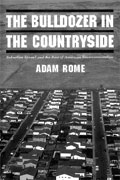The Bulldozer in the Countryside

| THE BULLDOZER IN THE COUNTRYSIDE: SUBURBAN SPRAWL AND RISE OF AMERICAN ENVIRONMENTALISM By Adam Rome . Cambridge University Press . UK . 2001 |
Everybody wants a slice of the urban dream. Own a home - dream merchants tell you. Doesn't matter if you cannot live within the city. Live near it. Occupy the new houses being built after clearing large tracts of land, filling up open spaces, bulldozing hillocks, and disturbing the natural ecosystem - did someone say? Stretch the boundaries. Precisely the stuff urban sprawl is made of.
Imagine an assembly line construction of 17,000 homes on 3,500 acres of land costing US $135 million. Just on the borders of expanding cities. This was common in post-war US. Even today, in fact, and almost across the world.
The book is a study on the inter-relationship between the growth of suburban sprawl in the post-World War II period up to 1970, and the rise of environmental activism in the US. It unfolds the history of how environmental problems became part of the public agenda.
The book begins by discussing the rise of tract housing at a time when the country was desperately short of housing. The homebuilding industry had all but shut down during the Depression and the war. It then goes on to discuss the different stages in the evolution of the environmental critique of homebuilding, about disappearing open spaces, destruction of wildlife and natural ecosystems and emergence of new problems. The book culminates with an analysis of the attempt, in the early 1970s, to institutionalise a new way of thinking about metropolitan land use.
The overall story is chillingly similar to the phenomena Indian metropolises are now experiencing. Only the social and political roots are slightly different. It begins with the post-war revolution in construction. The adoption of mass production techniques and new technologies helped builders put hundreds of thousands of homes in environmentally sensitive areas including wetlands, steep hillsides, and floodplains. The result was more frequent flooding, costly soil erosion and drastic changes in wildlife populations. Because the cheapest and largest tracts were beyond the reach of municipal sewer systems, the use of septic tanks increased. However, failures in the system caused outbreaks of disease, groundwater contamination, and eutrophication of lakes. Moreover, builders abandoned regional traditions that kept homes warm in winter and cool in summer.
The problems emerged one by one. The septic tank problem began to concern federal housing administrators in the late 1940s. The first questions about the wisdom of building on sensitive lands came a few years later. In the mid-1950s. Fortune and Life published influential essays about the loss of open space in the late 1950s. In the early 1960s the US Geological Survey began to investigate the effects of suburban growth on water and soil.
By the mid-1960s hundreds of grassroots campaigns were up against the sprawl, to stop "the rape of the land". The debate centred on the question 'Would Nature survive the advance of civilisation?' From this emerged the concept of 'land ethic', which led to a critical shift in public policy - a shift, analysts called "the quiet revolution in land-use control". For generations, landowners had enjoyed extraordinary freedom to decide how to use their property, but governments at every level began to restrict that freedom in the 1960s. Yet, the 'revolution' had only mixed success.
There was opposition to these environmental points of view. This not only constituted arguments for economic interests, but embraced social and political arguments as well. Homebuilding was certainly a driving force in the economy - the core of a 'suburban-industrial complex'. But the power of the industry went beyond jobs and profits, because the single-family home was one of the defining symbols of 'the American way of life'. The issue of home-ownership was tied to ideas about democracy, freedom, and civic order.
The critique of reckless homebuilding also attacked the capitalist mode of economy. The author quotes economist K William Kapp saying, 'Capitalism must be regarded as an economy of unpaid costs, 'unpaid' in so far as a substantial portion of the actual costs of production remain unaccounted for in entrepreneurial outlays; instead, they are shifted to, and ultimately borne by, third persons or by the community as a whole.' According to the author, the building industry also did everything to reduce production costs by ignoring environmental burdens.
The book makes fascinating reading. Moreover, it holds valuable lessons for Third World policymakers. It is not necessary to commit mistakes to learn from them.
